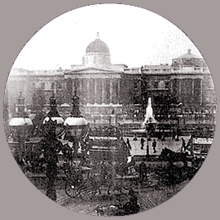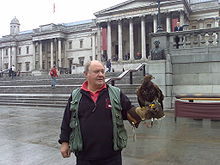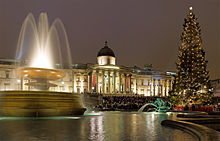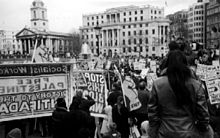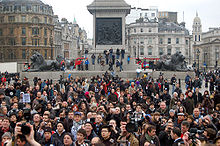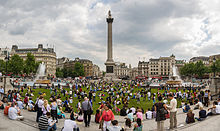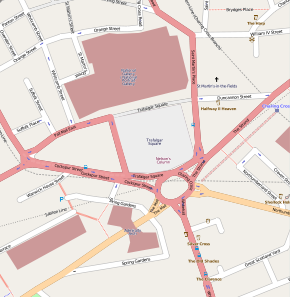
Trafalgar Square
Background to the schools Wikipedia
This selection is made for schools by a children's charity read more. Click here for more information on SOS Children.
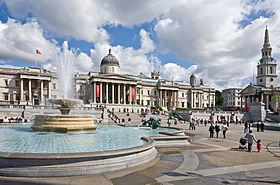 |
|
| Type | Square |
|---|---|
| Managed by | Greater London Authority |
| Country | United Kingdom |
| Region | London |
| UK Grid square | TQ 299 804 |
| Address | City of Westminster, London |
| Postcode | WC2 |
| Website | www.london.gov.uk/trafalgarsquare/ |
| Coordinates: 51°30′29″N 0°7′41″W | |
Trafalgar Square is a public space and tourist attraction in central London, built around the area formerly known as Charing Cross. It is in the borough of the City of Westminster. At its centre is Nelson's Column, which is guarded by four lion statues at its base. There are a number of statues and sculptures in the square, with one plinth displaying changing pieces of contemporary art. The square is also used for political demonstrations and community gatherings, such as the celebration of New Year's Eve.
The name commemorates the Battle of Trafalgar (1805), a British naval victory of the Napoleonic Wars over France. The original name was to have been "King William the Fourth's Square", but George Ledwell Taylor suggested the name "Trafalgar Square".
In the 1820s, George IV engaged the architect John Nash to redevelop the area. Nash cleared the square as part of his Charing Cross Improvement Scheme. The present architecture of the square is due to Sir Charles Barry and was completed in 1845.
Trafalgar Square is owned by the Queen in Right of the Crown, and managed by the Greater London Authority, while Westminster City Council owns the roads around the square, including the pedestrianised area of the North Terrace.
Layout
The square consists of a large central area with roadways on three sides, and a terrace to the north, in front of the National Gallery. The roads around the square form part of the A4 road.The square was formerly surrounded by a one-way traffic system, but works completed in 2003 reduced the width of the roads and closed the northern side to traffic.
Nelson's Column is in the centre of the square, flanked by fountains designed by Sir Edwin Lutyens in 1937-9 as replacements for two earlier fountains of Peterhead granite (now in Canada), and guarded by four monumental bronze lions sculpted by Sir Edwin Landseer. The column is topped by a statue of Horatio Nelson, the vice admiral who commanded the British Fleet at Trafalgar.
On the north side of the square is the National Gallery and to its east St Martin-in-the-Fields church. The square adjoins The Mall entered through Admiralty Arch to the southwest. To the south is Whitehall, to the east Strand and South Africa House, to the north Charing Cross Road and on the west side Canada House.
History
From the time of Edward I to the early nineteenth century, most of the area now occupied by Trafalgar Square was the site of the King's Mews, which stretched north from the position of the original Charing Cross, where the Strand from the City met Whitehall, coming north from Westminster.
Clearance and Development
From 1732, the King's Mews were divided into the Great Mews and the smaller Green Mews to the north by the Crown Stables, a large block, built to the designs of William Kent. Its site is now occupied by the National Gallery. The Royal Mews were transferred to Pimlico in the 1820s, and the stable block used as a menagerie, and for the storage of public records, until its demolition in 1835. In 1826 the Commissioners of H.M. Woods, Forests and Land Revenues instructed John Nash to draw up plans for clearing a large area south of Kent’s stable block, and as far east as St Martin’s Lane. His plans left open the whole area of what was to become Trafalgar Square, except for a block in the centre, which he reserved for a new building for the Royal Academy. They also involved the demolition and redevelopment of an area of buildings between St Martin’s Lane and the Strand, and the construction of a road (now called Duncannon Street) across the churchyard of St Martin-in-the-Fields. The Charing Cross Act was passed in 1826 and clearance of the ground started soon after.
After the initial clearance, development of the square progressed slowly. The National Gallery was built on the north side in 1832-8 to a design by William Wilkins, and in 1837 the Treasury approved Wilkins’ plan for the laying out of the square itself, but it was not put into effect. In April 1840, Wilkins having died in the meantime, new plans by Charles Barry were accepted, and construction started within weeks. For Barry, as for Wilkins, a major consideration was increasing the visual impact of the National Gallery, which had been widely criticised for its lack of grandeur. He dealt with the complex sloping site by excavating the main area of the square down to the level of the footway between Cockspur Street and the Strand, and constructing a fifteen foot high balustraded terrace with a roadway on the north side, with steps at each end leading down to the main level. Wilkins had proposed a similar solution, but with a central flight of steps. Plinths were provided for sculpture and pedestals for lighting. All the stonework was of Aberdeen granite. The estimated budget, excluding paving and sculptures, was £11,000. The earth removed was used to level Green Park. The next year it was decided that two fountains should be included in the layout. The square was originally paved with tarmacadam. This was replaced with stone in the 1920s.
Nelson's Column
Nelson’s Column had been planned independently of Barry’s work. In 1838 a Nelson Memorial Committee had approached the government, proposing that a monument to the victory of Trafalgar, funded by public subscription, should be erected in the square, and the government had provisionally agreed. A competition was held, the winning design, by the architect William Railton, being for a Corinthian column topped by a statue of Nelson, with an overall height of more than 200 feet, guarded by four sculpted lions. The design was approved, with the proviso that the overall height should be reduced to 170 feet, and construction began in 1840. The main construction of the column was completed, and the statue raised, in November 1843. However, the last of bronze reliefs on the pedestal of the column was not installed until May 1854, and The four lions, although part of the original design, were only added in 1867.
Barry was unhappy about Nelson’s column being placed in the square. In July 1840, when its foundations had already been laid, he told a parliamentary select committee "it would in my opinion be desirable that the area should be wholly free from all insulated objects of art".
Opening
The hoardings were removed and the square opened to the public on 1 May 1844, although the asphalt paving was still soft, and the fountains were not playing. There was still a hoarding around the base of Nelson’s column, which was to remain for some years, and some of its upper scaffolding remained in place.
The square has become a social and political focus for visitors and Londoners alike, developing over its history from "an esplanade peopled with figures of national heroes, into the country's foremost place politique", as historian Rodney Mace has written. Its symbolic importance was demonstrated in 1940 when the Nazi SS developed secret plans to transfer Nelson's Column to Berlin following an expected German invasion, as related by Norman Longmate in If Britain Had Fallen (1972).
Redevelopment
A major redevelopment of the square led by WS Atkins with Foster and Partners as sub-consultants was completed in 2003. The work involved closing the main eastbound road along the north side, diverting the traffic around the other three sides of the square, demolishing the central section of the northern retaining wall and inserting a wide set of steps leading up to a pedestrianised terrace in front of the National Gallery. The construction includes two lifts for disabled access, public toilets, and a small café. Previously, access between the square and the Gallery was by two crossings at the northeast and northwest corners of the square.
Statues and monuments
The plinths
Barry's scheme provided two plinths for sculptures on the north side of the square. A bronze equestrian statue of George IV by Sir Francis Chantrey, originally intended for the top of the Marble Arch, was installed on the eastern one in 1844, while the other remained empty until the late twentieth century. Two more statues on plinths were added during the nineteenth century; General Sir Charles James Napier by George Cannon Adams in the south-west corner of the square in 1855, and Major-General Sir Henry Havelock by William Behnes, in the south-east in 1861. In 2000, the then Mayor of London Ken Livingstone controversially expressed a desire to see the two generals replaced with statues of people "ordinary Londoners would know".
The Fourth Plinth
Since 1998 the empty plinth in the north-west corner of the square - which has become known as the "Fourth Plinth" – has been used to show a series of specially commissioned artworks. The scheme was initiated by the Royal Society of Arts and continued by a Fourth Plinth Commission, appointed by the Mayor of London. A 1:30 scale replica of HMS Victory in a giant glass bottle by Yinka Shonibare was installed on the plinth in May 2010.
Other statues
There are three busts of admirals against the north wall of the square. Those of Lord Jellicoe by Sir Charles Wheeler and Lord Beatty by William MacMillan were installed in 1948 in conjunction with the square's two fountains, which also commemorate the two men. A bust of the Second World War First Sea Lord Admiral Cunningham by Franta Belsky was unveiled alongside them on 2 April 1967.
On the south side of the square, on the site of the original Charing Cross, is a bronze equestrian statue of Charles I by Hubert Le Sueur. It was cast in 1633, and placed in its present position in 1678.
There are two statues on the lawn in front of the National Gallery: James II by Grinling Gibbons to the west of the portico, and George Washington, a replica of a work by Jean-Antoine Houdon, to the east. The latter, was a gift from the state of Virginia installed in 1921.
Two statues erected in the nineteenth century have since been removed. One, of Edward Jenner, the discoverer of vaccination, was set up in the south-west corner of the square in 1858, next to that of Napier. Sculpted by William Calder Marshall, it showed Jenner sitting in a chair in a relaxed pose, and was inaugurated at a ceremony presided over by Prince Albert. It was moved to Kensington Gardens in 1862. The other, of General Charles George Gordon by Hamo Thornycroft, was erected on an eighteen-foot high pedestal between the two fountains in 1888. It was removed in 1943 and re-sited on the Victoria Embankment ten years later.
Fountains
When the square was laid out in the 1840s, the fountains' primary purpose was not aesthetic, but rather to reduce the open space available and the risk of riotous assembly. They were originally fed by water pumped from an artesian well by a steam engine sited behind the National Gallery. In the late 1930s it was decided to replace the stone basins and the pump.The new fountains were built to a design by Sir Edwin Lutyens at a cost of almost £50,000. The old fountains were bought for presentation to the Canadian government, and are now in Ottawa and Regina. The present fountains are memorials to Lord Jellicoe (western side) and Lord Beatty (eastern side).
Further restoration work became necessary and was completed by May 2009. The pump system was replaced with a new pump capable of sending an 80-foot (24 m) jet of water into the air. A new LED lighting system was also installed during this restoration to reduce the cost of lighting maintenance. The new lighting has been designed with the London 2012 Summer Olympics in mind and for the first time will project many different combinations of colours on to the fountains. The new lighting system has a much lower energy requirement and will reduce its carbon footprint by around 90%.
Pigeons
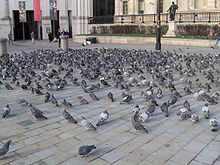
The square was once famous for its feral pigeons, and feeding them was a popular activity. The desirability of the birds' presence was contentious: their droppings disfigured stonework, and the flock, estimated at its peak to be 35,000, was considered a health hazard. In 2005, the sale of bird seed in the square was stopped and other measures introduced to discourage the pigeons, including the use of trained birds of prey. Groups of supporters continued to feed the birds, but in 2003 the then- Mayor, Ken Livingstone, enacted bylaws to ban the feeding of pigeons in the square. In September 2007 Westminster City Council passed further bylaws banning the feeding of birds on the square's pedestrianised North Terrace and other pavements in the area There are now few birds in Trafalgar Square and it is used for festivals and hired out to film companies in a way that was not feasible in the 1990s.
Uses
New Year events
For many years, revellers celebrating the start of a New Year have gathered in the square, despite a lack of civic celebrations being arranged. The lack of official events in the square was partly because the authorities were concerned that actively encouraging more partygoers would cause overcrowding. Since 2005, a firework display centred on London Eye and the South Bank of the Thames has been provided as an alternative.
VE Day celebrations
Victory in Europe Day (VE Day) was 8 May 1945, the date when the Allies during the Second World War celebrated the defeat of Nazi Germany. Trafalgar Square was filled with a crowd wanting to hear the formal announcement by Sir Winston Churchill that the war was over. The square was also used as a place of celebration by people travelling there from all over the country. On 8 May 2005 the BBC held a concert to celebrate the 60th anniversary of VE Day.
Christmas ceremony
There has been a Christmas ceremony at Trafalgar Square every year since 1947. A Norway Spruce (or sometimes a fir) is given by Norway's capital Oslo and presented as London's Christmas tree, as a token of gratitude for Britain's support during World War II. (Besides the general war support, Norway's Prince Olav, as well as the country's government, lived in exile in London throughout the war.) As part of the tradition, the Lord Mayor of Westminster visits Oslo in the late autumn to take part in the felling of the tree, and the Mayor of Oslo then comes to London to light the tree at the Christmas ceremony.
Political demonstrations
Since its construction, Trafalgar Square has been a venue for political demonstrations, though the authorities have often attempted to ban them. The 1839 fountains were added on their current scale to reduce the possibility of crowds gathering in the square as they were not in the original plans.
By March of the year Nelson's column opened, the authorities had started banning Chartist meetings in the square. A general ban on political rallies remained in effect until the 1880s, when the emerging Labour movement, particularly the Social Democratic Federation, began holding protests there.
On " Black Monday" (8 February 1886), protesters rallied against unemployment; this led to a riot in Pall Mall. A larger riot (called " Bloody Sunday") occurred in the square on 13 November 1887.
One of the first significant demonstrations of the modern era was held in the square on 19 September 1961 by the Committee of 100, which included the philosopher Bertrand Russell. The protesters rallied for peace and against war and nuclear weapons.
Throughout the 1980s, a continuous anti-apartheid protest was held outside South Africa House. More recently, the square has hosted the Poll Tax Riots (1990) and anti-war demonstrations opposing the Afghanistan war and the Iraq war.
The square was also scene to a large vigil held shortly after the terrorist bombings in London on Thursday, 7 July 2005.
In December 2009, participants from the Camp for Climate Action occupied the square for the two weeks in which the UN Conference on Climate Change took place in Copenhagen. It was billed as a UK base for direct action on climate change during the conference, and saw various actions and protests stem from the occupation.
On 26 March 2011, the square was occupied by protesters using the square to protest against the UK Budget and its proposed budget cuts. During the night however, the situation turned violent as the escalation by riot police and protesters damaged portions of the square.
Sports events
On 21 June 2002, 12,000 people gathered in the square to watch the England national football team's World Cup quarter-final against Brazil on giant video screens which had been erected specially for the occasion.
In the early 21st century, Trafalgar Square has become the location to the climax for sporting victory parades. It was used by the England national rugby union team on 9 December 2003 to celebrate their victory in the 2003 Rugby World Cup, and then on 13 September 2005 for the England national cricket team's victory in The Ashes.
On 6 July 2005 Trafalgar Square was a gathering place for the announcement on London's bid to host the 2012 Summer Olympics, Located also on Trafalgar Square is its Official Countdown Clock unveiled on 14 March 2011.
In 2007, it hosted the opening ceremonies of the Tour de France.
Other uses
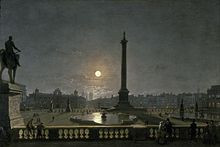
As an archetypal London location, Trafalgar Square featured prominently in film and television productions during the Swinging London era of the late 1960s, including The Avengers, Casino Royale, Doctor Who, The Ipcress File and Man in a Suitcase. It was also used as a filming location for several sketches and a cartoon backdrop in the BBC comedy series Monty Python's Flying Circus.
In May 2007, the square was grassed over with 2,000 square metres of turf for two days as part of a campaign by London authorities to promote "green spaces" in the city.
Every year on the anniversary of the Battle of Trafalgar (21 October), the Sea Cadet Corps holds a parade in honour of Admiral Lord Nelson and the British victory over the combined fleets of Spain and France at Trafalgar. The Areas of the Sea Cadet Corps are represented by seven 24-cadet platoons. The National Sea Cadet Band also parades, as does a Guard and Colour Party.
On 7 July 2011, due to building works in Leicester Square, the world premiere of the final film in the Harry Potter series, Harry Potter and the Deathly Hallows - Part 2, was held in Trafalgar Square, with a 0.75 mile red-carpet linking the two squares. Fans camped in Trafalgar Square for up to three days before the premiere. It was the first premiere ever to be held in Trafalgar Square.
Since 2006 the there have been annual celebrations of Canada Day (1 July), initiated by the Canadian community in the United Kingdom, endorsed by the Canadian High Commission, sponsored by Canadian companies, and organised by a private promotions company. The event features Canadian performers, Canadian food kiosks, and a street hockey tournament, among other activities.
Access
Nearest London Underground stations:
- Charing Cross – Northern and Bakerloo Lines—has an exit in the square. The two lines originally had separate stations, of which the Bakerloo Line one was called Trafalgar Square; they were linked and renamed in 1979 as part of the construction of the Jubilee Line, which was later rerouted to Westminster tube station in late 1999.
- Embankment – District, Circle, Northern and Bakerloo Lines.
- Leicester Square – Northern and Piccadilly lines
Bus routes running through Trafalgar Square:
- 6, 9, 11, 12, 13, 15, 23, 24, 29, 53, 87, 88, 91, 139, 159, 176, 453.
Other Trafalgar Squares
A Trafalgar Square in Stepney is recorded in Lockie's Topography of London, published in 1810. National Heroes Square in Bridgetown, Barbados, was originally named Trafalgar Square in 1813, before its better-known British namesake; it too had a statue of Admiral Horatio Nelson. Its name was changed on 28 April 1999.
There is also a Trafalgar Square in Barre, Massachusetts. The suburb of Waterloo in the city of Lower Hutt, New Zealand, features a Trafalgar Square opposite the Waterloo Interchange Railway Station, a major metropolitan hub.



